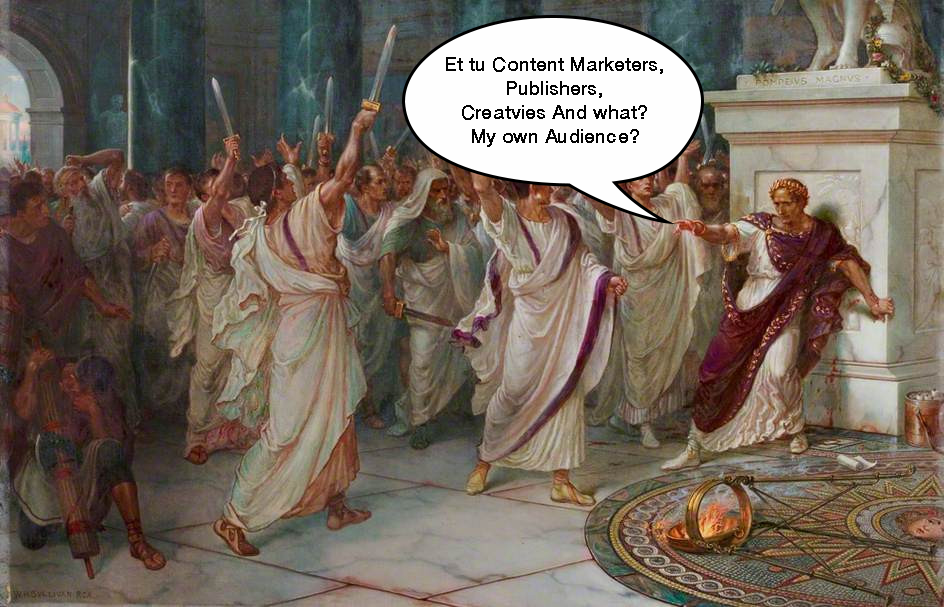

Advertising didn’t die; it was murdered!

By Simon Kearney, CEO and Tom Radford, Innovation Director
Who killed advertising? The Internet. That was mere manslaughter, the real murderers ran amok on advertising in thoughtless fury – and no one is bringing them to justice – nor will they.
Huh? You say. Read on. It may be the perfect crime.
Let’s look at the conspirators.
- The audience
- The publishing platforms and creative tools
- The creatives
- The publishers
- The content marketers
Needless to say, echoing Julius Creaser’s violent murder in the Senate in AD43, it was a conspiracy by everyone to bring down the boss. But why?
Suspect 1. The Audience

Interesting and entertaining things have not changed, but we have. The Internet has basically turned the audience into bosses, millions upon millions of them. At the same time, advertising just got too big. It had to go.
An empowered public got to decide what they see, when and what format it must take. It’s not much different to the end of absolutism in governance.
If the audience don’t like it, they don’t just NOT buy it, they start making horrible noises like a spoilt, demanding child who screams #KillYourBrand if he doesn’t get to go on the X-Box.
If you remember the NYPD campaign on Twitter where they were bombarded by photos of police brutality, or the infamous ‘Why do I shop at Waitrose?’ (an upmarket supermarket chain in the UK) campaign that backfired spectacularly when a number of wits used it as a platform to lampoon the brand for being posh.
At the same time we hit peak advertising, from a few hundred ads a day in the 1970s, it became okay in recent years to bombard us with tens of thousands. Every moment of our day was one long ad break.
Suspect 2. Publishing Platforms and Creative Tools
The pressure to create and out-do the old masters is encouraging us to self-publish. Everything that an advertiser used to do is now at the fingertips of the consumer and they often do better than the experts.
This power to create and publish has put yet greater scrutiny and pressure on marketers who are scrabbling to look for ways that they can turn it to their advantage. Do something better than I can from the comfort of my own home or get out of my face!
The interesting thing is that it is splitting the difference between the natural creatives (more on this next) and the technicians.
Operating a camera used to be half art and half technical knowledge. Now someone with very little technical knowledge can achieve the same results with the new tools, such as your mobile phone camera and an app.
Using Canva (a graphic design and publishing app) and iMovie (Apple’s consumer video editing software) anyone with an idea and the driving force to execute on it can achieve what it would have taken a team of people ten years ago.
Suspect 3. Natural Creatives
Natural creatives are those that just do something well. And since the advent of YouTube, Instagram, amazing photo and video quality in your pocket and apps that can recreate the technical ability of a master colourist they have been doing exactly that.
Twitter and blogging platforms have made stars of natural journalists who never spent a day in a newspaper. A school kid can put together a cool website, for free, that performs better than a six-figure custom build by a digital agency. The kid next door can score a million YouTube subscribers while a multi-billion dollar company spending millions on the same thing will only garner a few thousand.
These folks are undermining the execution side of the advertising business. Marketers are rightly saying why pay for all that stuff when amateurs are getting better results and are doing it on a shoestring.
Suspect 4. The Publishers.
This is where we see some howlers. The publishers used to have it all, glory, status, and loads, and loads, of cash. (I’m using the term publishers to encompass the mass media – print, TV and radio).
But they’ve been victims of hubris, not recognising the enemy at the gate until they let the Trojan horse in and parked it next to where the printing presses used to be.
Turns out most people liked the wooden horse and what was in it. The publishing business model changed before they realised what danger they were in. If publishing isn’t a successful industry, neither is advertising.
Suspect 5. The content marketers
That’s us right? Well, to be honest the advertisers are simply morphing into content marketers because they have to.
Advertising can finally get that sense of well being they’ve always sought by going all Dalai Lama and getting reincarnated as a force for good in the world.
Marketing used to lead with advertising, our prediction is that marketing will soon lead with content. Advertising (or media agencies, more accurately) will step in to promote the best of that content. Already large companies like GE work this way. Content sits apart and marketing jumps in when they produce something that works organically.
So that’s it then, advertising is dead?
Probably not, we just wanted to kill something in this blog. Advertising has its place, so does PR and all the other disciplines that come under the broad sweep of marketing services.
But will it end up like the dystopian world author and technologist, Jaron Lanier wrote about in his seminal book Who Owns the Future where even the birds and the skies convey programmatic, targeted advertising messages? Doubtful.
History shows that when you attempt to decide for people, what they should watch, listen to, etc, especially now, look for an exit strategy, or the people will find one for you.
Viva La Revolucion.








